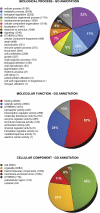De Novo assembly of the Manila clam Ruditapes philippinarum transcriptome provides new insights into expression bias, mitochondrial doubly uniparental inheritance and sex determination
- PMID: 21976711
- PMCID: PMC3258041
- DOI: 10.1093/molbev/msr248
De Novo assembly of the Manila clam Ruditapes philippinarum transcriptome provides new insights into expression bias, mitochondrial doubly uniparental inheritance and sex determination
Abstract
Males and females share the same genome, thus, phenotypic divergence requires differential gene expression and sex-specific regulation. Accordingly, the analysis of expression patterns is pivotal to the understanding of sex determination mechanisms. Many bivalves are stable gonochoric species, but the mechanism of gonad sexualization and the genes involved are still unknown. Moreover, during the period of sexual rest, a gonad is not present and sex cannot be determined. A mechanism associated with germ line differentiation in some bivalves, including the Manila clam Ruditapes philippinarum, is the doubly uniparental inheritance (DUI) of mitochondria, a variation of strict maternal inheritance. Two mitochondrial lineages are present, one transmitted through eggs and the other through sperm, as well as a mother-dependent sex bias of the progeny. We produced a de novo annotation of 17,186 transcripts from R. philippinarum and compared the transcriptomes of males and females and identified 1,575 genes with strong sex-specific expression and 166 sex-specific single nucleotide polymorphisms, obtaining preliminary information about genes that could be involved in sex determination. Then we compared the transcriptomes between a family producing predominantly females and a family producing predominantly males to identify candidate genes involved in regulation of sex-specific aspects of DUI system, finding a relationship between sex bias and differential expression of several ubiquitination genes. In mammalian embryos, sperm mitochondria are degraded by ubiquitination. A modification of this mechanism is hypothesized to be responsible for the retention of sperm mitochondria in male embryos of DUI species. Ubiquitination can additionally regulate gene expression, playing a role in sex determination of several animals. These data enable us to develop a model that incorporates both the DUI literature and our new findings.
Figures







Similar articles
-
Nuclear genes with sex bias in Ruditapes philippinarum (Bivalvia, veneridae): Mitochondrial inheritance and sex determination in DUI species.J Exp Zool B Mol Dev Evol. 2013 Nov;320(7):442-54. doi: 10.1002/jez.b.22520. Epub 2013 Jul 19. J Exp Zool B Mol Dev Evol. 2013. PMID: 23873694
-
Deciphering the Link between Doubly Uniparental Inheritance of mtDNA and Sex Determination in Bivalves: Clues from Comparative Transcriptomics.Genome Biol Evol. 2018 Feb 1;10(2):577-590. doi: 10.1093/gbe/evy019. Genome Biol Evol. 2018. PMID: 29360964 Free PMC article.
-
Multi-tissue RNA-Seq Analysis and Long-read-based Genome Assembly Reveal Complex Sex-specific Gene Regulation and Molecular Evolution in the Manila Clam.Genome Biol Evol. 2022 Dec 7;14(12):evac171. doi: 10.1093/gbe/evac171. Genome Biol Evol. 2022. PMID: 36508337 Free PMC article.
-
Doubly uniparental inheritance: two mitochondrial genomes, one precious model for organelle DNA inheritance and evolution.DNA Cell Biol. 2009 Feb;28(2):79-89. doi: 10.1089/dna.2008.0807. DNA Cell Biol. 2009. PMID: 19196051 Review.
-
The unusual system of doubly uniparental inheritance of mtDNA: isn't one enough?Trends Genet. 2007 Sep;23(9):465-74. doi: 10.1016/j.tig.2007.05.011. Epub 2007 Aug 6. Trends Genet. 2007. PMID: 17681397 Review.
Cited by
-
Doubly uniparental inheritance of mitochondria as a model system for studying germ line formation.PLoS One. 2011;6(11):e28194. doi: 10.1371/journal.pone.0028194. Epub 2011 Nov 29. PLoS One. 2011. PMID: 22140544 Free PMC article.
-
Identification and expression analysis of Sox family genes in echinoderms.BMC Genomics. 2024 Jul 1;25(1):655. doi: 10.1186/s12864-024-10547-0. BMC Genomics. 2024. PMID: 38956468 Free PMC article.
-
SmithHunter: a workflow for the identification of candidate smithRNAs and their targets.BMC Bioinformatics. 2024 Sep 2;25(1):286. doi: 10.1186/s12859-024-05909-0. BMC Bioinformatics. 2024. PMID: 39223476 Free PMC article.
-
Faraway, so close. The comparative method and the potential of non-model animals in mitochondrial research.Philos Trans R Soc Lond B Biol Sci. 2020 Jan 20;375(1790):20190186. doi: 10.1098/rstb.2019.0186. Epub 2019 Dec 2. Philos Trans R Soc Lond B Biol Sci. 2020. PMID: 31787048 Free PMC article.
-
Relaxed selection on male mitochondrial genes in DUI bivalves eases the need for mitonuclear coevolution.J Evol Biol. 2021 Nov;34(11):1722-1736. doi: 10.1111/jeb.13931. Epub 2021 Sep 29. J Evol Biol. 2021. PMID: 34533872 Free PMC article.
References
-
- Altschul SF, Gish W, Miller W, Myers EW, Lipman DJ. Basic local alignment search tool. J Mol Biol. 1990;215:403–410. - PubMed
-
- Arbeitman MN, Furlong EE, Imam F, Johnson E, Null BH, Baker BS, Krasnow MA, Scott MP, Davis RW, White KP. Gene expression during the life cycle of Drosophila melanogaster. Science. 2002;297:2270–2275. - PubMed
-
- Bayrer JR, Zhang W, Weiss MA. Dimerization of doublesex is mediated by a cryptic ubiquitin-associated domain fold: implications for sex-specific gene regulation. J Biol Chem. 2005;280:32989–32996. - PubMed
-
- Beissbarth T, Speed TP. GOstat: find statistically overrepresented Gene Ontologies within a group of genes. Bioinformatics. 2004;20:1464–1465. - PubMed
Publication types
MeSH terms
Substances
Grants and funding
LinkOut - more resources
Full Text Sources

